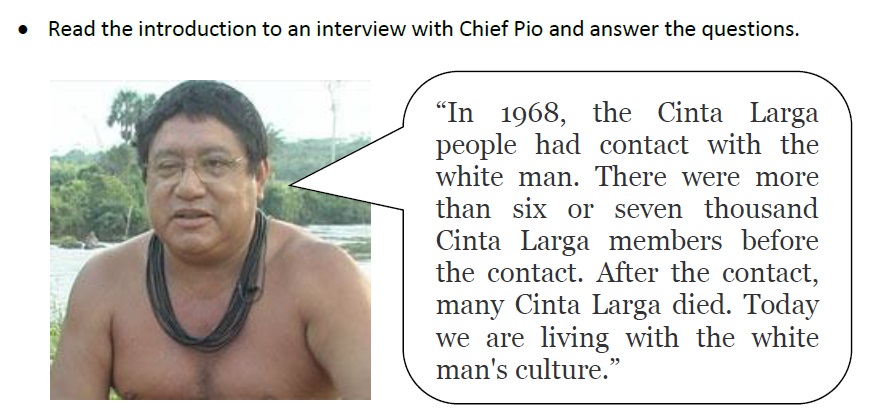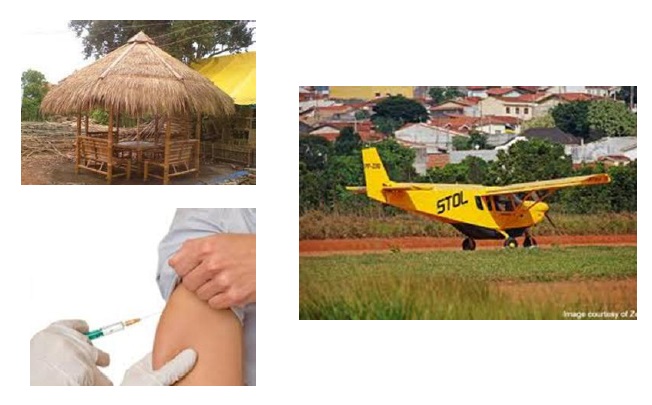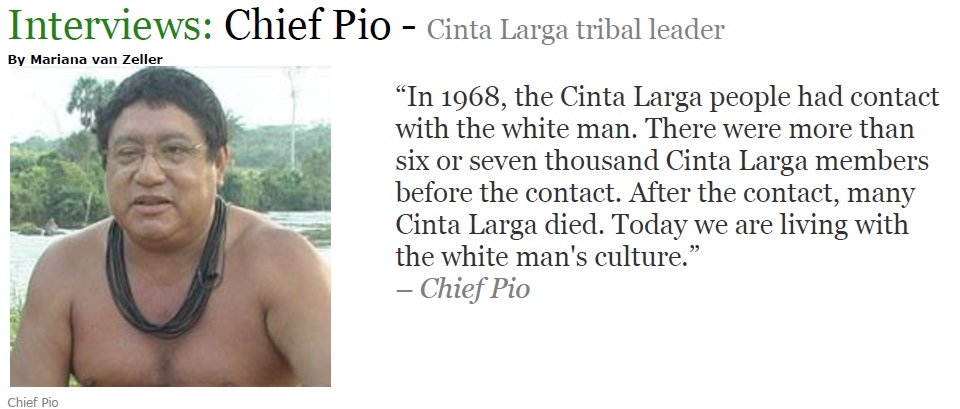LEMAD - Laboratório de Ensino e Material Didático – História - FFLCH - USP
Oficina livre: “Elaborando materiais didáticos com a temática indígena”
Proposta de sequencia didática elaborada por
Maria Dolores Wirts Braga
a partir das atividades da oficina - 28/05/2012
SEQUÊNCIA DIDÁTICA
Título: Indigenous peoples in Brazil: past, present and future
Objetivo geral: viabilizar a abordagem da temática indígena para o ensino de inglês como língua estrangeira na escola de ensino regular (pública e/ou privada).
Objetivos específicos: promover o interesse dos alunos e professores de inglês sobre a cultura indígena em nosso país; atualizar as representações imaginárias sobre o elemento indígena brasileiro em relação à sua diversidade étnica, cultural, linguística e política e, principalmente, em relação à postura não estática e atemporal das sociedades indígenas em nosso país.
Objetivos linguísticos: revisão de tempos verbais (passado, presente e futuro), compreensão de texto, prática escrita e oral.
Sugestões de procedimentos (Teacher’s guidelines):
1. Informe seus alunos sobre os Cinta Larga. Você poderá se referir ao texto da entrevista e/ou pesquisar na internet (sugestão: http://pib.socioambiental.org/pt/povo/cinta-larga). Você desejar, você poderá explorar a foto do Chefe Pio, pedindo para os alunos adivinharem onde ele mora, que língua(s) ele fala (a língua falada pelo povo Cinta Larga pertence ao grupo linguístico conhecido como Tupi Mondé), se ele fala inglês etc. A informação básica necessária para a elaboração dos exercícios é que os Cinta Larga moram em Rondônia e no Mato Grosso, em uma área rica em diamantes, que atrai muitos mineiros. Devido à lei brasileira que proíbe a exploração de terras indígenas, os mineiros iniciaram secretamente a exploração das minas de diamante no território Cinta Larga. Percebendo a insistência dos mineiros em explorar suas terras, os Cinta Larga começaram a cobrar uma quantia em dinheiro em troca da permissão para adentrar seu território e explorar os diamantes. Logo, os mineiros descobriram um meio de
entrar no território Cinta Larga, sem fazer o pagamento devido. Quando os Cinta Larga perceberam que estavam sendo desafiados, iniciou-se uma luta terrível. O governo interferiu e cessou a luta. Todos aguardaram para ver quem tinha o direito de explorar as minas de diamantes. O que você e seus alunos acham: quem tem o direito de explorar os diamantes? Agora, os Cinta Larga negociam a exploração de parte de seu território.
2. Peça para os alunos lerem os dizeres do Chefe Pio e faça perguntas para verificar a compreensão. Por exemplo:
* O que aconteceu em 1968? *Quantas pessoas havia antes da chegada dos mineiros? * O que aconteceu depois do contato com os mineiros?
3. Leia as instruções para o exercício 1. Explique o vocabulário e peça aos alunos para discutirem e responderem em grupos. Não confira as respostas agora; apenas após a leitura da entrevista.
4. Distribua as perguntas aos grupos de alunos e peça que imaginem como o Chefe Pio as responderia. Os alunos escrevem a resposta imaginada no espaço reservado da questão 2. Os grupos que responderam à mesma pergunta podem, se desejarem, discutir suas respostas após escrevê-las.
5. Peça para os alunos procurarem no texto da entrevista a resposta do Chefe
Pio à pergunta trabalhada pelo grupo e compararem as respostas.
6. Os alunos relatam os resultados encontrados à turma. Se desejar, disponibilize o esqueleto de uma possível resposta na lousa:
Pensamos que ................................ . Mas/E, o Chefe Pio disse que ................ .
7. Peça aos alunos que leiam o resto da entrevista e verifiquem as respostas do exercício 1. Você poderá querer expandir essa atividade, pedindo que os alunos façam algumas comparações entre a vida dos Cinta Larga antes e depois da chegada dos mineiros em seu território.
8. Discuta qualquer aspecto do texto ou do tema que possa ser de interesse para os alunos.
9. Como atividade extra, seus alunos poderão querer obter mais informações sobre os povos indígenas no Brasil. Eles poderão acessar o blog dos Cinta
Larga e entrar em contato com eles: http://povocintalarga.blogspot.com.br/.
///////////////////////////////////////////////////////////////////////////////////////////
Tiras para as discussões dos alunos. Distribua uma tira por grupo.
Você conhecia diamantes antes da vinda dos mineiros?
Você se lembra da primeira vez que viu um não índio?
Você teve medo (quando viu um não índio pela primeira vez)?
Há um bom relacionamento entre os mineiros e o povo Cinta Larga?
Os Cinta Larga sabem extrair minérios?
O que você deseja para o futuro dessa mina?

1. Tick the items you believe the Cinta Larga people have got in their community and/or use or wear in their day-to-day lives.

( ) shoes
( ) clothes
( ) health posts
( ) thatched roofs
( ) soccer fields
( ) airstrips
( ) cars
( ) nurses
They have got …………………………………… . // They haven’t got ……………………………………………… .
They use …………………………………………… . // They don´t use …………………………………………………… .
They wear ………………………………………… . // They don’t wear ……………………………………………… .
2. In groups, choose a slip with a question to answer. Then, compare your answer to Chief Pio’s
answer.
(write your group’s answer here) :
_____________________________________________________________________________________________________________
_____________________________________________________________________________________________________________
____________________________________________________________________________________________________________.
Teacher’s guidelines
1. Inform your students about the Cinta Larga people. You can use ideas from the text and/or research about them in the net (suggestion: http://pib.socioambiental.org/pt/povo/cinta- larga). If you wish, you could explore the picture of Chief Pio by asking students to guess where he lives, what languages he speaks (the Cinta Larga language belongs to the group known as Tupi Mondé), if he speaks English, etc. The basic information required for the exercises is that the Cinta Larga live in Rondônia and Mato Grosso in an area rich in diamonds which attracts lots of miners. Since it is prohibited to explore indigenous lands in Brazil, miners started to extract the diamonds secretly. The Cinta Larga charged miners a sum of money to allow them to go into their territory to get the diamonds. Soon, some miners found a way not to pay the Cinta Larga and a terrible fight began. The government interfered and stopped the fight. They all waited to see who had the right to explore the mines. Who do you and your students think has the right to the diamonds? Now, the Cinta Larga allow the exploration of part of their territory and charge for that.
2. Ask students to read Chief Pio’s words. Then, ask questions to check understanding. For instance,
* What happened in 1968? * How many people were there before the miners arrived? * What happened after their contact with the miners?
3. Read the instructions for exercise 1. Explain the vocabulary and ask students to decide on the answers in groups. Sts should use complete sentences to report back their answers to the class. Answers will be checked later on, after the reading of the text.
4. Distribute the slips with questions to the groups of sts and ask them to imagine what was Chief Pio’s answers. Sts write down their answers for exercise 2. Groups working on the same question may get together and share their ideas after writing them down.
5. Ask students to look at the complete text and find Chief Pio’s answers for the question they worked with. Students compare his answer and their group’s answer to the question.
6. Ask students to report the results back to the class. You may wish to provide the skeleton of
a possible answer: We thought …………………………… . But/ And, Chief Pio said that …………………. .
7. Ask students to read the rest of the text and check their answers for exercise 1. You may
wish to expand this activity by asking students to compare the Cinta Larga people’s lives before and after the arrival of the miners in their territory.
8. Discuss any aspect of the text or topic which might interest students.
9. As an extra activity, your students might like to search for more information about indigenous peoples in Brazil. They may as well like to access the Cinta Larga people’s blog and contact them
at http://povocintalarga.blogspot.com.br/.
///////////////////////////////////////////////////////////////////////////////////////////
Slips for student’s discussion. Hand out one slip for each group.
What do the (Cinta Larga) children want?
Did you know what diamonds were before miners started coming here?
Do you remember the first time you saw a white man? How was it?
Were you scared (when you saw a white man for the first time)?
Is there a good relationship between miners and Cinta Larga people?
Do the Cinta Larga know how to mine?
What do you want for the future of this mine?
Jewel of the Amazon: January 24, 2006
http://www.pbs.org/frontlineworld/stories/brazil501/interview_pio.html

Frontline/World Reporter Mariana van Zeller: How was life before the contact with the white man?
Chief Pio: Before it was wonderful too. We never had to worry about diseases, education,
health, of being invaded by the white man in the village. Today, we don’t have that peace anymore. Because today, it’s “Ah, in that place there are wood cutters stealing wood. Ah, in that
place rubber tree tappers are invading the reserve.” So we have to be constantly running from
one place to the other. Things have changed a lot. We ourselves are different. We have worries -
- worries about health, worries about our children, worries about women, because now there are
shoes, clothes. Before it wasn’t like this. Before, Indians were only worried about hunting in the right season, working at the right time, picking native fruit in the right season. So we didn’t have as many worries then. I didn’t even imagine at that time that there were roads. I didn’t even imagine at that time that there were soccer fields, airstrips, dams. We weren’t prepared for any of that.
And you have all of that now?
Yes, after the contact, we have all that. You can see we have health posts, nurses. The village
now has tiled roofs, instead of thatched. So many things have changed after the contact with the
white man. I think that we have two cultures: one white and one indigenous, and that’s confusing our youngsters. They don’t know the old culture. And we would like to teach them. What do the children want?
The kids here just want to know about soccer, about white man’s stuff, so I think the Cinta
Larga aren’t living their old lives anymore. Money has changed the lives of the Cinta Larga. The truth is we don’t want that. We want both cultures. We want to have cars and those other
things that the white man has brought here. We weren’t the ones who went looking for any of
that. It was the white man’s culture that came looking for us. So today we want what’s best for us. Because today we know that if our youngsters study and graduate, we will have someone to defend us. We won’t need to hire lawyers to defend our rights. Today we know we have that right. But how can we get it? That’s what we still don’t know.
What do you want for the future of this mine?
We want to explore this diamond mine. We don’t want to give it to the white man. We can talk to the government, reach an agreement with them. But we need to hear their proposals, and we want them to hear ours. That’s what we’re fighting for with the government. We want to set up
our own Indian mining company so that we Indians can explore the mine. Not that we want to
explore it till there’s nothing left, but explore it when we need to. That is our proposal to the government. We haven’t seen any proposal from the government yet. We’re waiting for them to
send us a proposal. We would like for them to come talk to us.
You mention an Indian mining company, but do the Cinta Larga know how to mine?
Well, we didn’t know, but we are learning. Today we still need help from the white man because we haven’t learned everything. We still need a PC machine operator. That’s what we need in order to be able to mine.
For the mine to be legalized, the Cinta Larga tribe is going to have to give authorization. Will you?
We still haven’t seen the government’s proposal, to see if they are going to legalize it for the
Indians or for the mining companies. That’s what we need to know, to talk to the government. How has life changed in the village during these last years with the presence of all these miners?
On the one hand it improved, on the other it got worse because life has become more stressful.
Today, I can see the negative side of the mine -- people lost their marriages, some members are separated, women go to the city. That was the bad side. The positive side and where the mine
has benefited the community is in the building of well-built houses, roads, agricultural projects;
and it brought cattle. I think the treatment has to be differentiated. We are Indians so we should be treated differently from the white man. So today we have a different health system, different educational system, because not all of us know how to speak Portuguese.
Did you know what diamonds were before miners started coming here?
No. No. We made contact with them here in the river. When I was little, I followed a miner but I
didn’t understand why he was working with the gravel. But now we know. At the time we didn’t even know what money was. Today we know what money and diamonds are, so we learned all that.
Do you remember the first time you saw a white man?
Yes.
How was it?
They weren’t very close; I saw them from far away. It was in Tenente Marques. Some miners
passed by, and I hid behind a tree looking at them pass. I thought they were weird.
Why did you think they were weird?
They had clothes on, everything was different -- shoes, canoes -- it was all new to me.
Were you scared?
Yes, I was scared. Very. [He laughs.] We knew that they didn’t speak our language and that
made things difficult.
Do you think you’re lucky or unlucky to have this diamond mine in the reserve? We’re here with the blessing of God, and if God left it here, it was lucky for us. Maybe it’s not a
question of being lucky or unlucky, but God left it here for whoever explores it.
Joao Bravo says that if it’s necessary, we will fight and we won’t hand over the mine easily. So
I’m not sure what the government is thinking, and we’ve been living here for a long time, so we won’t let the government do that. We want to wait for the government to legalize this for us. I don’t know if this is the best mine in the world because I’ve never seen diamonds from anywhere else. If the white men say that these are the best diamonds in the world, it’s because they know diamonds from other regions. I don’t. The miners had permission from the Indians to mine here. But then more started to come in and there were more Indians bringing them in, then we just started losing control.
So there was a good relationship between miners and Indians?
Yes.
And you don’t think that exists anymore?
It still exists, but today you see the federal police everywhere, so if the government doesn’t want us to mine, what can we do? We’re not going to fight with the government, so we have to
wait. We can’t keep on working clandestinely and fight with the government. We don’t want
that. We want to work legally.
Are you hopeful about the future of this mine?
Yes, I’m hopeful, and that’s why I’m cooperating with the FUNAI and with the federal police,
so that better things can come to the Cinta Larga people.
And do you think the miners are also going to be able to benefit in some way?
I can’t answer that because I don’t know.
| Anexo | Tamanho |
|---|---|
| seq_didatica_cinta_larga.pdf | 564.3 KB |
| seq_didatica_CintaLarga2.pdf | 627.61 KB |
| seq_didatica mapa aldeia Guarani.pdf | 343.49 KB |

